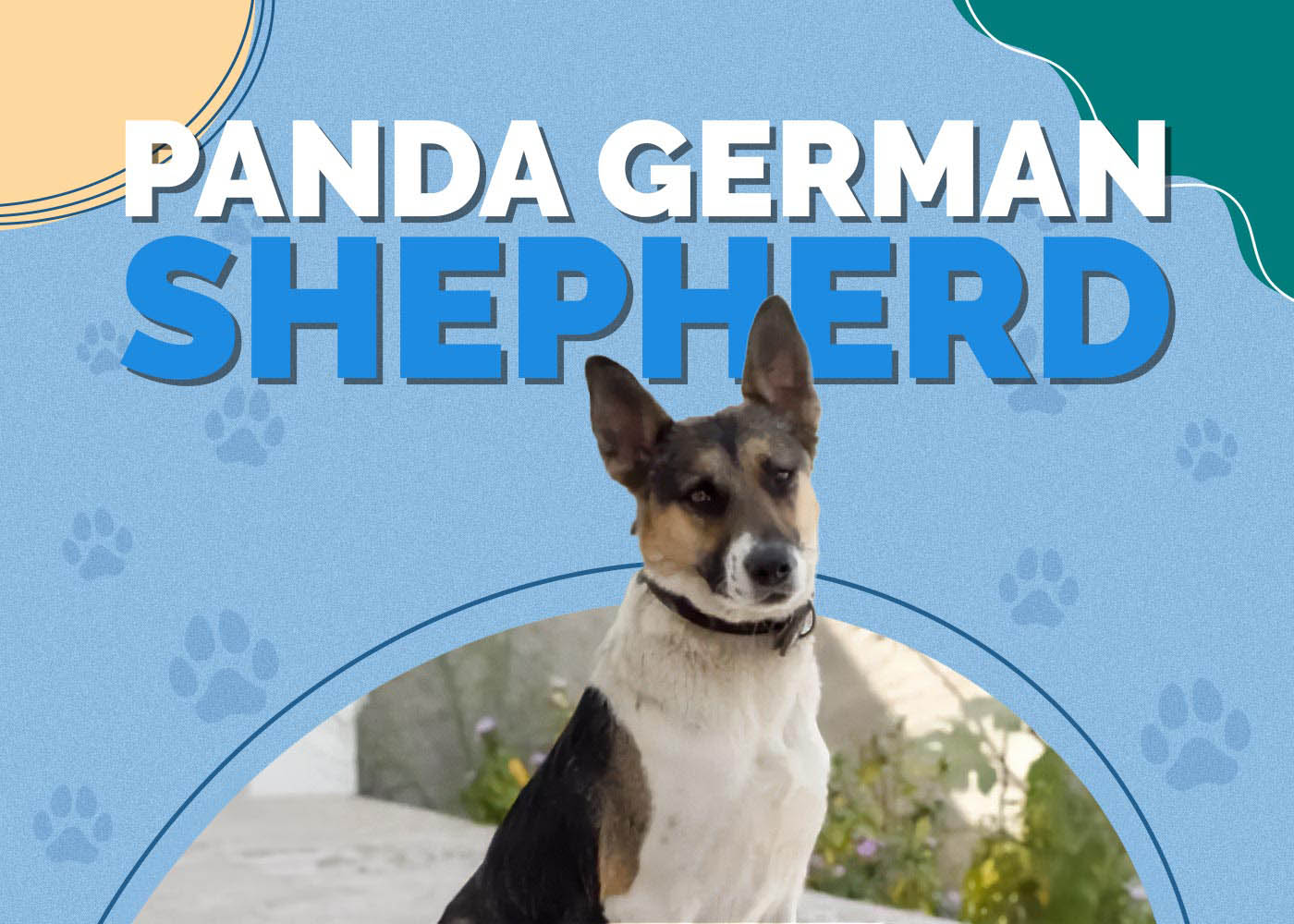Panda German Shepherd: Info, Pictures, Characteristics & Facts
Updated on

| Height: | 22–26 inches |
| Weight: | 49–88 pounds |
| Lifespan: | 9–13 years |
| Colors: | Black and white |
| Suitable for: | Active families, those with previous dog-owning experience |
| Temperament: | Protective, devoted, intelligent |
Panda German Shepherds are like ordinary German Shepherds, except they have a rare genetic mutation that causes white spotting. They don’t always look exactly like pandas, and their spotting can take many forms. However, the white markings are prominent enough that the “panda” name stuck.
This genetic mutation may have occurred early in the breed. However, the first recorded instance was in 2000. A female spontaneously developed the white fur. At first, it was assumed that the dog had been crossbred.
However, genetic testing by UC-Davis revealed that a genetic mutation had occurred. It was named the CD117 gene. Another DNA test proved the female’s lineage, and her AKC registration helped determine that she was a purebred German Shepherd.
This gene is dominant, which means that any dog with a single version of the gene can display the coloration. However, it appears to be deadly in the embryonic stage. If a puppy inherits two Panda genes, they will not develop correctly and survive long enough to be born.
There is controversy about the coloration since it is not in the breed standards. It is considered a fault. Despite the scientific evidence, many breeders also claim that the gene is caused by crossbreeding. Others claim that dogs are from inferior stock, but there is no evidence.
Panda German Shepherd Puppies
Panga German Shepherds are rare and aren’t regularly available. The “panda” gene didn’t exist in the population until 2000. Its low acceptance by breeders has led to very few people breeding for the color. However, a few kennels specialize in Panda German Shepherds.
Because of their rarity, you can expect to pay thousands of dollars to purchase one. You’ll likely need to be on a waiting list for a couple of years. In general, you can only find Panda German Shepherds at breeders. They aren’t common enough to show up at rescues or shelters.
3 Little-Known Facts About the Panda German Shepherd
1. Panda German Shepherds Are Purebred
Many traditional breeders claim that the “Panda” results from mixed breeding by using Collies or similar dogs. However, genetic testing has shown that it is a spontaneous coloration. In other words, dogs with the Panda gene are purebred. Their common ancestor had a rare genetic mutation that changed her color.
2. The Panda Gene Can Be Lethal
This gene is dominant. However, if a puppy receives two of the genes, then it will not develop correctly. Therefore, this gene is considered to be lethal in the womb. Luckily, this can be avoided by not breeding two Panda dogs together.
3. Panda Is a Relatively New Coloration
This color is relatively new. It wasn’t until 2000 that a female German Shepherd spontaneously mutated and displayed the Panda gene.
Temperament & Intelligence of the Panda German Shepherd 🧠
The German Shepherd is a working dog, first and foremost. This applies to the Panda German Shepherd as well. The panda gene only affects the dog’s coloration, and they act exactly like a standard German Shepherd.
They were made to work for much of the day, so their exercise needs are pretty high. We only recommend them for active families. You can expect them to need at least 2 hours of moderate to intense physical activity every day. That equates to about 10 miles of walking if the only exercise you do is walking.
German Shepherds are also incredibly smart. They aren’t the most intelligent breed but are brighter than most. For that reason, you’ll likely need to provide plenty of mental stimulation as well. This can be accomplished through the use of training and puzzle toys. Some games, like hide-and-seek, can also challenge your dog’s mind.
Without the proper mental stimulation, your German Shepherd will attempt to find their own fun. Usually, it results in destructive behaviors. When your dog is bored, your couch may suddenly look like a lovely chew toy.
The German Shepherd is eager to learn and easy to train. They are devoted to their owners and bond closely with them, though they aren’t the friendliest around strangers. They can become protective of their people if they are not socialized properly. They make excellent guard dogs for that reason, but they still require training to perform the task correctly. Training is vital for them to be accepting of strangers.
Are Panda German Shepherds Good for Families? 🏡
German Shepherds are known for being very devoted to their families. They can be good with children as long as they are socialized with them at a young age. Otherwise, they may be unsure of smaller children’s erratic behavior. When raised around small children, they are friendly and playful.
Panda German Shepherds are smart dogs, and teaching them how to behave around children is easy. They can learn to play hide-and-seek and various other games that most children will love. They attach themselves equally to everyone in the family, unlike other breeds that seem to be bonded to one person.
Do Panda German Shepherds Get Along with Other Pets? 🐶 😽
Some German Shepherds get along perfectly fine with other dogs. Others can be pretty protective of their space and people, which can make adopting another dog difficult. It depends on how socialized your German Shepherd is. If they are around other dogs often, they will likely get along with them. After all, they’ll learn that other dogs aren’t a threat to them. Their presence will be “normal.”
However, if your dog is not used to other canines, they may interpret them as a threat. Usually, German Shepherds are not good with cats or other small animals. Their prey drive is too high, so they chase anything they perceive as a prey animal.
Socialization helps, but you will never eliminate their pretty drive.
Things to Know When Owning a Panda Shepherd
Food & Diet Requirements 🦴
Panda German Shepherds don’t require special diets but need 3½ to 4 cups of high-quality dry food daily as adults. They’re large dogs, so choosing a puppy food specifically designed for larger breeds is crucial. They need plenty of protein, fat, and other nutrients to develop correctly. A typical puppy food won’t work for them and may lead to health problems later.
For instance, large dogs need less calcium than smaller puppies. If they consume too much, they can be at greater risk for hip dysplasia and similar conditions. German Shepherd puppies don’t stop growing until they are around 2 years of age, and you’ll have to wait a while before switching to an adult formula.
It is unnecessary to choose a food that explicitly says “German Shepherd” on the bag. Besides their nutritional needs as puppies, German Shepherds do not need a special blend designed for them. Most breed-specific recipes have very few differences from regular dog food. Some don’t have any differences at all.
Panda German Shepherd Exercise Requirements 🐕
German Shepherds are energetic dogs that are only recommended for active families. Panda German Shepherds have the exact needs as any other German Shepherd since their genetic mutation only affects their coloration.
You should plan on exercising your German Shepherd for at least two hours a da, which can include walks, playtime, active training, and various other activities.
German Shepherds likely won’t want to exercise for 2 hours straight, though many of them could. Instead, spreading it out into two or three sessions is safer. A lack of exercise can lead to behavioral problems, such as tearing up furniture or eating your belongings.
Training Needs for Panda Shepherds 🦮
German Shepherds are relatively easy to train, smart, and very devoted to their owners. Unlike some other breeds, they will easily respond to commands in real-life situations. Their need to please often overrides everything else.
However, German Shepherds require extensive training. If they are not trained, it is easy for them to get bored. Furthermore, They can be highly protective of their owners. They can become aggressive if they are not socialized as puppies. Puppy classes are highly recommended, as they can provide the socialization and training your puppy needs.
As with many dogs, proper training is critical to having a well-behaved German Shepherd.
Panda Shepherd Grooming ✂️
German Shepherds have a reasonably thick coat. They also shed quite a bit, so their grooming needs are extensive. They don’t need regular professional sessions if you keep up with their grooming at home. You should brush your German Shepherd a few times a week, but brushing them daily is ideal. Otherwise, dead hair, dirt, and debris can quickly build up in their coat.
Brushing can remove much of the hair and keep the dog’s coat nice and clean. Otherwise, you’ll end up needing to bath your dog more often – which is much harder than giving them a quick brush. Bathing can also cause skin sensitivities and itchiness. Dogs were not meant to be bathed very often.
Most German Shepherds do not develop matted fur, but some with long hair might develop a few tangles. This makes brushing them even more critical.
Panda Shepherd Health and Conditions ❤️
German Shepherds are relatively healthy, and working animals tend to be the healthiest. Those bred for shows are not always healthy, as confirmation tends to be highest on the breeder’s list.
Luckily, many health tests can be performed on German Shepherds before they are bred. They ensure that only the healthiest dogs are bred together. Be sure to ask the breeder you purchase from for this health testing information.
Ask for the parent’s CHIC number so you can independently see the results of essential health tests. If a dog doesn’t have one, the breeder has not done the proper health testing before producing the litter of puppies.
German Shepherds are prone to quite a few health conditions. Hip dysplasia is prevalent, especially for dogs with sloped backs. Hip and elbow dysplasia can cause arthritis-like signs when the dog is young. It develops as the dog grows, so it usually appears very early. Some dogs don’t show signs until they are around three, however.
Degenerative myelopathy is also common in German Shepherds. A test is available, and a breeder who does appropriate health testing will likely be able to prevent it from popping up in their puppies. You can also purchase the test for your puppy yourself and request that it be done before you finalize the adoption.
This step is unnecessary if the breeder provides health testing for both parents. German Shepherds also have a higher-than-average occurrence of Von Willebrand disease, which is an inherited bleeding disorder. It’s treatable, but there is no cure. Most of the time, the dog will be on life-long medications and supplements.
- Cardiac heart defects
- Panosteitis
- Pannus
- Von Willebrand disease
- Degenerative myelopathy
- Hip and elbow dysplasia
Male vs. Female
There is little difference between male and female German Shepherds. The males are a bit larger, which is also true for those with the Panda coloration. Males weigh around 65–90 pounds, while females weigh 50–70 pounds.
Beyond the size difference, there is no significant difference between the sexes. We recommend not setting your sights solely on a male or female when looking for a Panda German Shepherd. The dogs are so rare that you may not have a choice and have to adopt the first pup available.
Final Thoughts: Panda Shepherd
Panda German Shepherds are controversial canines. This coloration results from a sudden and rare genetic mutation that occurred in a single female in 2000. The mutation caused her to have white spotting, hence the “panda” name. Despite the strange coat color, They’re purebred dogs. They act and look exactly like your usual German Shepherd beside the white spotting.
The panda color is not recognized by any kennel clubs, even though it results from a natural mutation. It will likely not be recognized for some time, as it is rare, and breed standards don’t get changed very often.
While they look different, it is essential to remember that they have the exact needs of an ordinary German Shepherd. In other words, you’ll need to exercise them daily, brush them many times a week, and commit to socialization and training sessions.
We only recommend these dogs for active families. Previous experience with dogs is beneficial. Either way, plan on enrolling your Panda German Shepherd in obedience classes ASAP. Group lessons are preferred for the socialization aspect.
Featured Image Credit: Reza Abdollahi, Shutterstock












